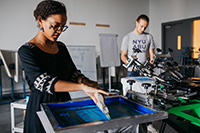-
Academics
-
Admissions
 Your journey to NYUAD starts here. Attend an application workshop or information session.Admissions Events
Your journey to NYUAD starts here. Attend an application workshop or information session.Admissions Events -
Research
-
Campus Life
 Live the possibilities. Be part of a dynamic community of students from over 115 countries.Take a Tour
Live the possibilities. Be part of a dynamic community of students from over 115 countries.Take a Tour - Public Programs
-
About
Exceptional education. World class research. Community-driven.Our Story
- News
- Events
- Social Media Directory
- Press Room
-
- Torch at NYUAD
- Faculty
- Current Students
- Alumni
- عربي
Rana El Danaf
Senior Research Scientist
Affiliation: NYU Abu Dhabi
Education: PhD Virginia Commonwealth University, Richmond, Virginia
Research Areas: Neuroscience, Drosophila Melanogaster, Visual system, Development
The visual system of Drosophila provides a powerful model for understanding how the specificity of connections between different neuronal subtypes arises during development. It is comprised of four neuropils (lamina, medulla, lobula and lobula plate) that are each essential for processing various visual stimuli. Projection neurons in the lobula, including the lobula columnar neurons (LCs), are thought to integrate different visual cues and send that information to the central brain via their axonal projections, leading specific behavioral outputs to be manifested in response to these stimuli. LCs comprise several subtypes that are characterized by unique morphological and functional properties. Interestingly, each LC subtype projects to a distinct optic glomerulus forming highly specific, neighboring yet non-overlapping synaptic domains. The aim of Rana’s research is to understand how this precise pattern of axon-target matching occurs throughout development, as well as to uncover the mechanisms controlling this process.
Prior to joining the Desplan lab, Rana completed her postdoctoral studies at the University of California San Diego, and joined the Department of Neurobiology at Stanford University as a research scientist. During that time, Rana designed and carried out studies aimed to understand visual system development, organization and disease in rodent and non-human primate models. The main goal of her research was to understand the progression of neurodegeneration in glaucoma, the second leading cause of blindness in the world. A hallmark feature of this disease is the death of retinal ganglion cells (RGCs), the neurons that connect the eyes to the brain. Work that Rana performed on this showed that specific RGC subtypes are more susceptible to injury and then, death, in response to a well-established rodent glaucoma model. These findings aimed towards the identification of clinically relevant biomarkers, which can potentially allow for earlier detection of the disease.
